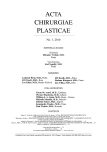MINIABDOMINOPLASTY
Autoři:
J. Měšťák; O. Měšťák
Působiště autorů:
Charles University, Prague, Czech Republic
; Department of Plastic Surgery, 1st Medical Faculty
Vyšlo v časopise:
ACTA CHIRURGIAE PLASTICAE, 52, 1, 2010, pp. 23-26
INTRODUCTION
Laxity of the abdominal wall in women after delivery, or women with a pendulous abdomen, is one of the defects which frequently require plastic surgery intervention. While in women after delivery the main complaint is flaccid and wrinkled skin of the anterior abdomen, extensive striae in the area of the navel and lower abdomen may also be found, along with diasthasis recti in patients with a pendulous abdomen, persistent eczema under the overhanging skin, and various orthopedic, vascular and other complications.
However, in clinical practice we frequently see abdomen that do not require radical mobilization of the whole abdominal wall from mons pubis and inguinal area to subcostal area, involving postpartum status or status after weight loss (1, 2). In such cases the laxity of the abdominal wall is localized only to the lower or upper abdomen, while the epigastrium or hypogastrium is in a relatively very good condition and does not require correction. Frequently we find changes in the lower half of the abdomen, such as excess tissue to the abdominal pannus, while the upper half is firm and stretched. Both cases can be solved individually with what may be termed a miniabdominoplasty, which is classified depending on location as an upper or lower abdominoplasty (3).
METHOD
Miniabdominoplasty constitutes an operative method of partial abdominal wall correction (Fig. 1). It is an alternative to the classic abdominoplasty. In lower abdominoplasty the cut is horizontal above the mons pubis and the groin area of the abdominal pannus, mobilizing the dermis and hypodermis to the navel and laterally to the sides of the mesogastrium. After the loose skin has been pulled caudally we reduce the excess tissue. Then we thin the whole area of hypodermis under the elevated flap all the way to the scarpa’s fascia and fix the flap with several stitches to the abdominal wall. Prior to skin suture we insert Redon’s drain and leave it in for 24 hours (Fig. 2–7).


A less frequent indication for miniabdominoplasty is loose skin in the area above the navel, while the lower part of the abdomen does not require correction. The upper abdominoplasty requires more time and is more technical. We use the original surgical method according to Longacre (4), where a decorticated flap of the abdominal wall is used for the augmentation of hypoplastic breasts. In upper miniabdominoplasty the decorticated flap is used for fixation of the mobilized wall to the ribs. Similar principles are used in extensively mobilized abdominal epigastric wall, the basis for some reconstructive methods after mastectomies.
The surgery itself consists of flap decortications in the shape of a half-moon under the breast fold, followed by caudal skin and hypodermis release almost to the navel. After the upper edge and external lower edge of the decorticated flap are detached we fix the flaps under tension to the rib periosteum externally and cranially above the level of the breast fold, so the lower flap edge corresponds with this fold. It is beneficial to insert a few stitches to stabilize the mobilized and cranially moved protruded abdominal wall. After upper miniabdominoplasty a drain is not usually used, because the released wall is fixed by strips of adhesive plaster, and an elastic bandage is added. Sometimes, if the mesogastrium is not damaged, we can perform upper and lower miniabdominoplasty at the same time, which efficiently corrects a flaccid abdominal wall throughout its entire extent without leaving a noticeable vertical scar along the whole wall and changing the naval shape (Fig. 8–16).

In the postoperative course we remove the intradermal stitches between day 14 and 17. Elastic underwear should be worn after a lower abdominoplasty for 3–4 weeks and after an upper abdominoplasty for 4–6 weeks. Physical stress is possible 4 to 6 weeks after surgery.
CONCLUSION
In the cases indicated, the advantages of partial abdominoplasty are indisputable. Lower miniabdominoplasty in particular takes less time and demands a lower level of technical skills compared to the traditional abdominoplasty, while also allowing for early rehabilitation and recondition. Upper miniabdominoplasty corrects laxity of the upper abdomen with less pronounced scars placed in the breast folds compared to the vertical scars in the epigastrium resulting from traditional abdominoplasty, if these are necessary for abdominal correction. The fact that the navel remains in situ, often without significant circular scarring, can be considered a further point in favor of partial abdominoplasty.
Address for correspondence:
Ass. Prof. Jan Měšťák, PhD.
University Hospital Na Bulovce
Budínova 2
180 00 Prague 8
Czech Republic
E-mail: mestak@gmail.com
Zdroje
1. Měšťák J., Víšek V., Čakrtová M., Červený J. Dermolipectomy of the abdominal wall. Acta Chir. Plast., 30, 1988, p. 182-191.
2. Regnault P. Abdominoplasty by the W technigue. Plast. Reconstr. Surg., 55, 1975, stránky p. 265-274.
3. Vasconez LO., Torre JI. Abdominoplasty. In Mathes J. (ed.) Plastic Surgery, 2nd ed. Saunders, 2006, p. 158-165.
4. Longacre JJ. Correction of the hypoplastic breast with special reference to reconstruction of the “nipple type breast with local dermo-fat pedicle flaps. Plast. Reconstr. Surg., 14, 1954, p. 431-441.
Štítky
Chirurgia plastická Ortopédia Popáleninová medicína TraumatológiaČlánok vyšiel v časopise
Acta chirurgiae plasticae

2010 Číslo 1
- Metamizol jako analgetikum první volby: kdy, pro koho, jak a proč?
- Fixní kombinace paracetamol/kodein nabízí synergické analgetické účinky
- Kombinace metamizol/paracetamol v léčbě pooperační bolesti u zákroků v rámci jednodenní chirurgie
- Antidepresivní efekt kombinovaného analgetika tramadolu s paracetamolem
- Kombinace paracetamolu s kodeinem snižuje pooperační bolest i potřebu záchranné medikace
Najčítanejšie v tomto čísle
- NASAL DERMOIDS WITHOUT INTRACRANIAL EXTENSION IN TEENAGERS
- TREATMENT OF PARTIAL-THICKNESS SCALDS BY SKIN XENOGRAFTS – A RETROSPECTIVE STUDY OF 109 CASES IN A THREE-YEAR PERIOD
- MINIABDOMINOPLASTY
- NASAL RECONSTRUCTION IN CHILDREN WITH THE COMBINATION OF NASOLABIAL AND ISLAND FLAPS













